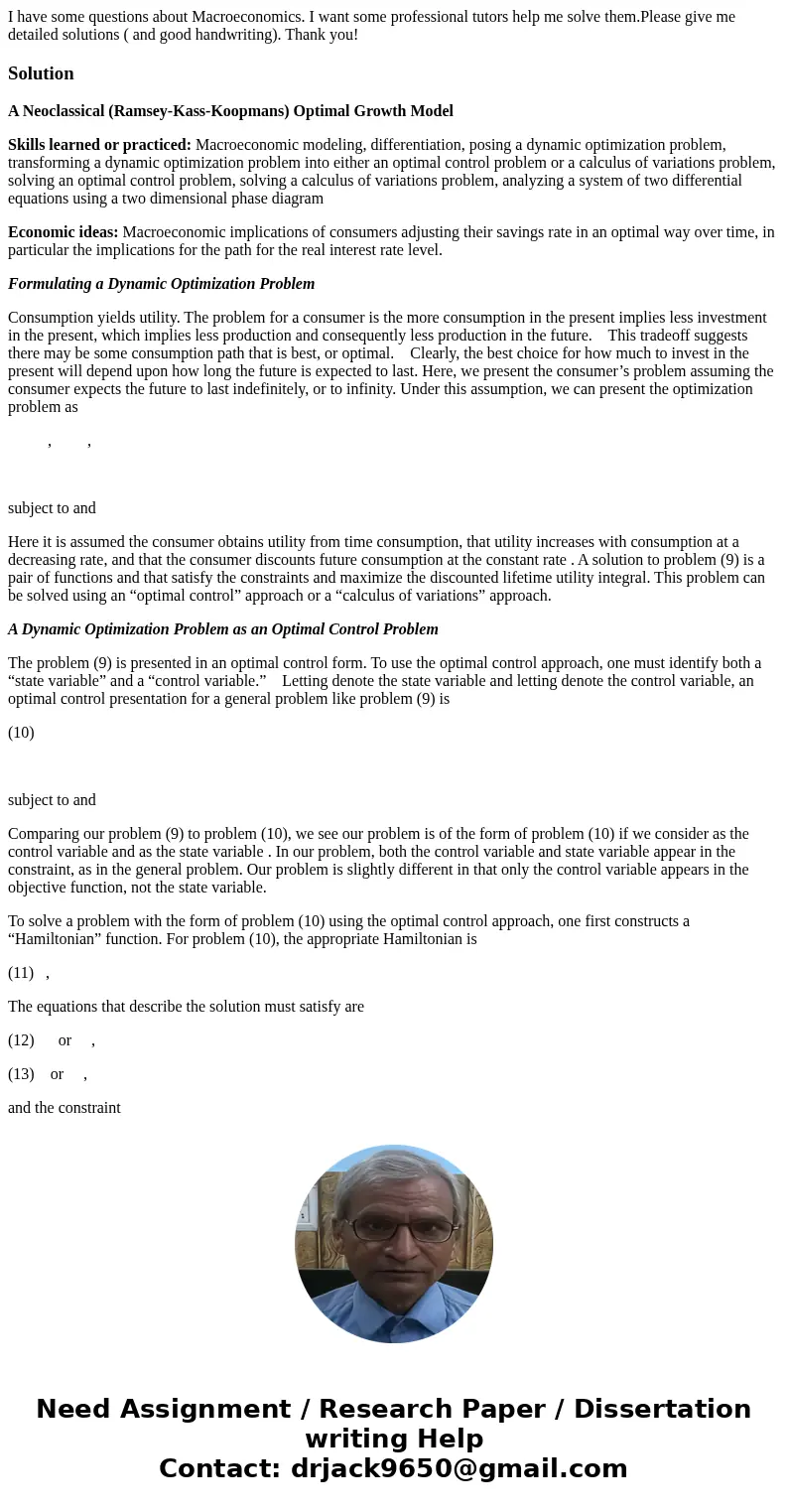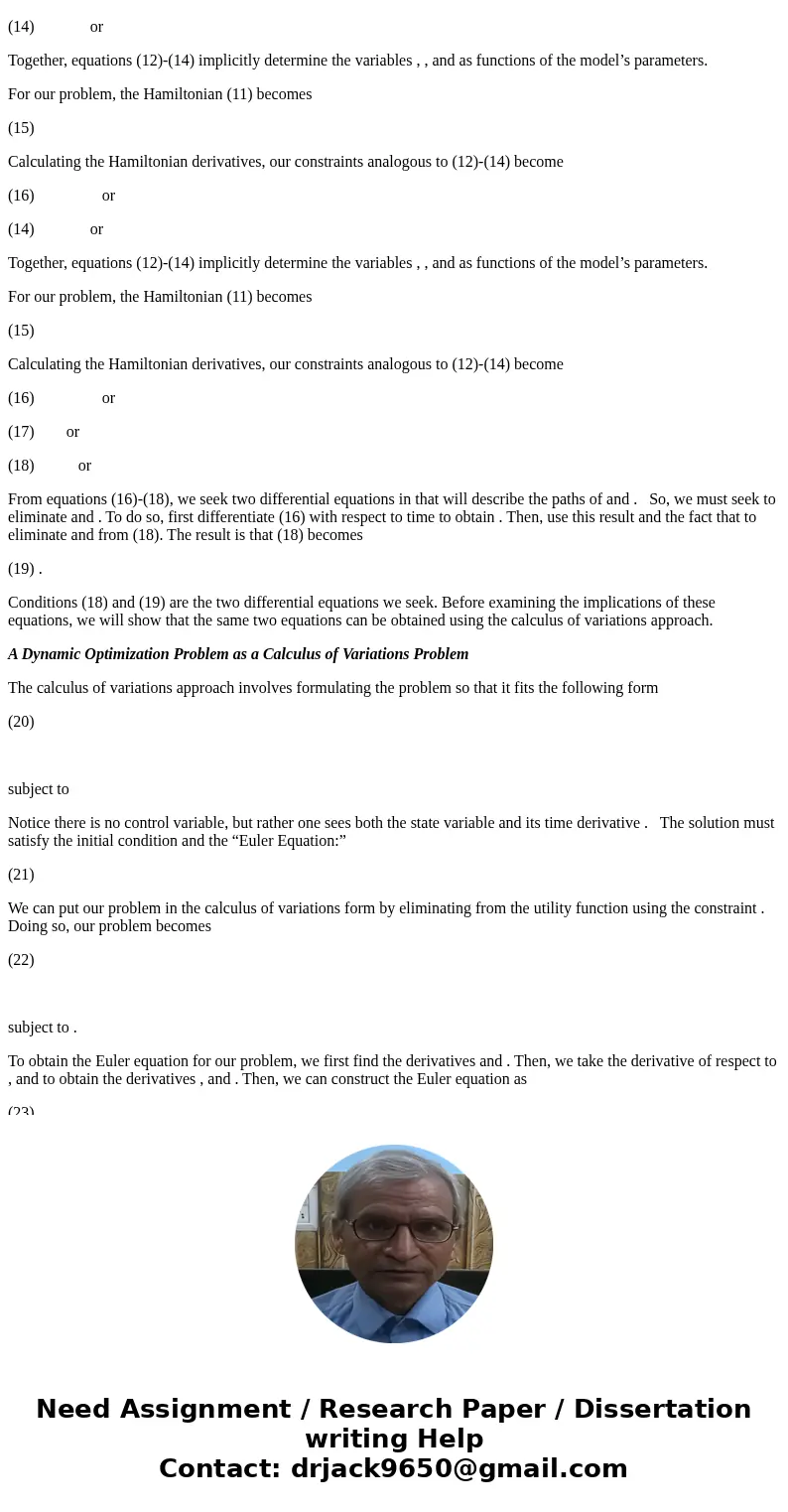I have some questions about Macroeconomics I want some profe
I have some questions about Macroeconomics. I want some professional tutors help me solve them.Please give me detailed solutions ( and good handwriting). Thank you!
Solution
A Neoclassical (Ramsey-Kass-Koopmans) Optimal Growth Model
Skills learned or practiced: Macroeconomic modeling, differentiation, posing a dynamic optimization problem, transforming a dynamic optimization problem into either an optimal control problem or a calculus of variations problem, solving an optimal control problem, solving a calculus of variations problem, analyzing a system of two differential equations using a two dimensional phase diagram
Economic ideas: Macroeconomic implications of consumers adjusting their savings rate in an optimal way over time, in particular the implications for the path for the real interest rate level.
Formulating a Dynamic Optimization Problem
Consumption yields utility. The problem for a consumer is the more consumption in the present implies less investment in the present, which implies less production and consequently less production in the future. This tradeoff suggests there may be some consumption path that is best, or optimal. Clearly, the best choice for how much to invest in the present will depend upon how long the future is expected to last. Here, we present the consumer’s problem assuming the consumer expects the future to last indefinitely, or to infinity. Under this assumption, we can present the optimization problem as
, ,
subject to and
Here it is assumed the consumer obtains utility from time consumption, that utility increases with consumption at a decreasing rate, and that the consumer discounts future consumption at the constant rate . A solution to problem (9) is a pair of functions and that satisfy the constraints and maximize the discounted lifetime utility integral. This problem can be solved using an “optimal control” approach or a “calculus of variations” approach.
A Dynamic Optimization Problem as an Optimal Control Problem
The problem (9) is presented in an optimal control form. To use the optimal control approach, one must identify both a “state variable” and a “control variable.” Letting denote the state variable and letting denote the control variable, an optimal control presentation for a general problem like problem (9) is
(10)
subject to and
Comparing our problem (9) to problem (10), we see our problem is of the form of problem (10) if we consider as the control variable and as the state variable . In our problem, both the control variable and state variable appear in the constraint, as in the general problem. Our problem is slightly different in that only the control variable appears in the objective function, not the state variable.
To solve a problem with the form of problem (10) using the optimal control approach, one first constructs a “Hamiltonian” function. For problem (10), the appropriate Hamiltonian is
(11) ,
The equations that describe the solution must satisfy are
(12) or ,
(13) or ,
and the constraint
(14) or
Together, equations (12)-(14) implicitly determine the variables , , and as functions of the model’s parameters.
For our problem, the Hamiltonian (11) becomes
(15)
Calculating the Hamiltonian derivatives, our constraints analogous to (12)-(14) become
(16) or
(14) or
Together, equations (12)-(14) implicitly determine the variables , , and as functions of the model’s parameters.
For our problem, the Hamiltonian (11) becomes
(15)
Calculating the Hamiltonian derivatives, our constraints analogous to (12)-(14) become
(16) or
(17) or
(18) or
From equations (16)-(18), we seek two differential equations in that will describe the paths of and . So, we must seek to eliminate and . To do so, first differentiate (16) with respect to time to obtain . Then, use this result and the fact that to eliminate and from (18). The result is that (18) becomes
(19) .
Conditions (18) and (19) are the two differential equations we seek. Before examining the implications of these equations, we will show that the same two equations can be obtained using the calculus of variations approach.
A Dynamic Optimization Problem as a Calculus of Variations Problem
The calculus of variations approach involves formulating the problem so that it fits the following form
(20)
subject to
Notice there is no control variable, but rather one sees both the state variable and its time derivative . The solution must satisfy the initial condition and the “Euler Equation:”
(21)
We can put our problem in the calculus of variations form by eliminating from the utility function using the constraint . Doing so, our problem becomes
(22)
subject to .
To obtain the Euler equation for our problem, we first find the derivatives and . Then, we take the derivative of respect to , and to obtain the derivatives , and . Then, we can construct the Euler equation as
(23) ,
This reduces to . Differentiating (18) with respect to time, we know . This allows us to replace with and more conveniently write the Euler equation as
(24)
Notice that condition (24), obtained using the calculus of variations technique, is the same as condition (19) obtained using the optimal control technique. Together, the Euler equation (24) and the capital accumulation constraint (18) are a system of two differential equations that describe the paths of the optimal consumption and capital paths and .



 Homework Sourse
Homework Sourse